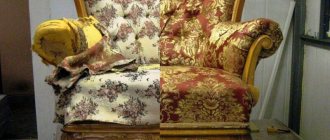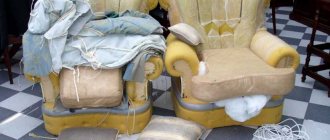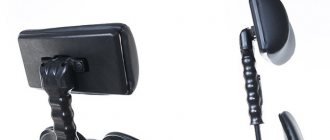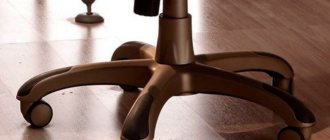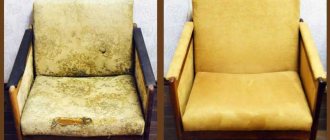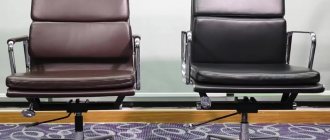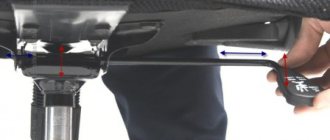Modern people spend a lot of time at the computer, both in the office and at home. Obviously, it is better to work not sitting on a hard stool or listening to the creaking of an old chair, but sitting comfortably in one of the office chairs offered by manufacturers. Unfortunately, from active use, the upholstery of the chair quickly becomes unusable - the artificial leather cracks or becomes frayed, the fabric gets dirty and torn. What should you do - throw away your expensive office chair or try to restore it?
Cleaning chairs or updating them is quite possible at home - you can reupholster this piece of furniture standing near the computer yourself, without going to any special workshops.
You will learn how to replace upholstery or remove unsightly stains from this article.
VIDEO: Do-it-yourself reupholstery of a computer chair.
Computer chairs are a very common piece of furniture.
The service life of a chair depends on its quality and the materials from which it is made.
Most often, the coating from which the seats and backs are made becomes deformed and loses strength.
Woven materials can tear if used carelessly, artificial leather cracks and becomes scuffed. The chair becomes uncomfortable and looks unsightly
Buying a new computer chair is an expensive solution to the problem.
But reupholstering an office chair is easy to do at home.
- You don't need to pay a master for the work.
- Upholstering a chair at home will take from 30 minutes to 1 hour - this is much faster than in a workshop.
- You don’t need to take the chair anywhere; you can replace the upholstery in your apartment.
- The costs of the procedure are minimal.
- Everyone has the necessary set of tools.
- Disassembling and assembling the chair is not at all difficult; you do not need any special skills. By re-upholstering the chair with your own hands, you can save both time and money.
- Take measurements from the back and seat. If you plan to add additional foam, you should take this point into account when taking measurements. To the data obtained (length and width of the back and chair) you need to add 5 cm. The fabric will be attached from the inside, for this you need allowances.
- You can first disassemble the chair and remove the old covering. This can cause difficulties, since the upholstery is tightly stapled to the frame parts. Then you should measure the finished darts, adding allowances for using foam rubber.
Necessary materials
To work, we first need fabric.
The best option is thick upholstery.
What materials should you not buy? There are few exceptions.
- Faux leather.
- Thin, lightweight fabric.
The canvas will quickly become scuffed and lose its original appearance due to constant friction.
Such material is susceptible to damage from sharp objects, including pointed elements on clothing.
If the seat has lost its former softness, and the foam lining is very wrinkled, then you need to buy foam rubber, it will make the chair more pleasant and comfortable.
It is easy to find in sewing stores.
Types of chairs
There are many different types of chairs, varying in level of comfort, cost, and methods of placement in space. The design is an “improved chair”, which has a soft back and seat covered with textiles, leather, faux leather, fur, and in some cases, armrests, a footrest, and a rocking mechanism.
The main classification looks like this:
- by purpose - for relaxation (interior), for work (office);
- according to design features - with a rigid frame, without a frame;
- at the place of installation - in the living room, in the garden or on the veranda, office (computer), gaming (game) rooms.
The design of the item itself is also different, there are:
- ordinary - installed on four legs, have a soft back, armrests, coffee stands, poufs, and other details that provide maximum comfort;
- chair-beds - designed for cramped rooms, significantly saving space. It is not recommended to constantly sleep on such furniture, but it is possible to place an unexpected guest who is staying overnight on it, and also to use it in a summer cottage;
- rocking chairs - made classic (on ski runners), with a pendulum mechanism (have a fixed base), spring (rattan papsan rocking chairs), as well as “Viennese chairs” (runners are connected in a closed circle);
- advertisers are especially comfortable, expensive models that can be fully reclined and have a footrest. Transformable manually or electrically. A ventilation system, mini-bar, vibration massage, etc. are sometimes built in here;
- hanging - it can be a hammock, an “egg”, a ball, a “cocoon”. Hanging is done on the ceiling, wall, stand, beam.
Frame models are made of natural wood, metal, plywood, chipboard, and plastic. Usually several materials are used at the same time. Frameless options are pillow bags filled with foam balls and synthetic fluff. There are also convertible, lightweight inflatable items.
How to update old furniture: ideas
Old chairs are often very strong and durable. But after a long period of use, they lose their attractive appearance. Do not rush to throw away such furniture, as it can be easily restored.
The technology for updating a chair depends, first of all, on its design. This can be done using several approaches:
- Pieces from the 60s can be restored simply by changing the upholstery.
This process is relatively simple. The main thing is to choose the right fabric style. Some designers recommend using several color shades that will fit into the overall interior. - Restoration of the external covering.
This approach involves changing the paint layer on wooden or metal surfaces. It is used for chairs made of rattan, wood, wicker and other natural products. This also includes restoration of natural or artificial leather (painting, cleaning, etc.). - Replacement of certain elements.
An old chair will look original if you replace the armrest with a product of a different shape. You can do the same with the legs or back. Here everything depends only on your imagination and capabilities.
Stages of work
Upholstering an office chair with your own hands is not as difficult a task as it might seem at first. It is not necessary to call a specialist if you have the necessary tools and materials at hand. For work you will need the following elements: fabric for covering, foam rubber, scissors or a knife, screwdrivers - Phillips and flat-head, furniture stapler.
Before starting work, the chair must be disassembled. It's easier to do this if you have instructions. But often there is none, so you need to understand the device and properly disconnect the cover and seat. It is better to take a photo of the chair before disassembling and at the next stages, because this will make it easier to reassemble it after repair.
The simple product has standard fasteners, so reupholstering an office chair with your own hands will not take much time. It is enough to unscrew the bolts and screws in certain places. Once the parts of the chair are disassembled, you can begin to remove the old upholstery. To do this, use pliers, a screwdriver and an anti-stapler if there are staples. After this, using the measurements of the old cladding, we make patterns on the new material. To do this, simply attach the products to each other and trace the outline.
Next, you should lay the material on the floor in this order: sheathing component, foam rubber and frame (back or seat). Then fasten the first one well to the frame, while pulling it well - do not make folds, but carefully secure the result with a stapler. Upholstering an office chair with leather not only gives the furniture an updated look, but also increases the status of the organization, especially in the eyes of clients. When both parts are covered, you can put the chair back together and enjoy the work done.
Fabric selection
When choosing fabric for upholstery, you must remember that the fabric must be dense and quite durable
It is important that the material is easy to clean and, if possible, impregnated with a special water-repellent solution. In addition, the conditions in which the chair will be used are immediately thought through.
For example, if there are pets in the apartment, then it is better to purchase anti-vandal material, for example, flock. Such a coating will not break through the claws of cats or dogs and will not even become covered with snags.
For a chair in a children's room, chenille or matting is more suitable, which do not wear out from everyday use, but are easily cleaned from stains and other consequences of children's games. The advantages of these materials include:
- density;
- naturalness;
- long service life.
An armchair in the living room should look impressive, so it is better to give preference to materials such as:
- jacquard;
- tapestry;
- leather.
It is better to choose fabrics with a distinct pattern that demonstrates the good taste of the owners.
Master classes on upholstery of chairs
So, how to reupholster a chair with your own hands step by step is quite a troublesome task; it is important to take into account all the manipulations described above. At the same time, there are certain secrets that will help you perform the job at the highest level.
Here are a few of them:
- If the chair stands on legs, then you must first cover the entire end part and the rear lower bar with fabric. Only after this the leg is fixed. In this case, you will need to carefully make a hole in the fabric. You should not leave the holes for the legs untightened at the time of reupholstery, as the fabric in this place will gradually stretch and tear.
- If the armrests are soft, then it is better to do the upholstery in this order - first the back, then the seat and only then the armrests. The elements are fixed to the frame in the same sequence. In this case, it will be possible to avoid distortions or so-called “bubbles” on the foam rubber. The work will look neat and high quality.
You will get a beautiful chair without extra costs.
Remember that these tips will help you upholster upholstered furniture - not just an armchair. If everything is implemented correctly, the result will be such that it will be impossible to distinguish it from the factory one.
Repair and design of the frame
Chair restoration begins with preparatory work:
Use rags and soft brushes to clean all surfaces of dirt. Any soap solution will do for this.
It is important to do this quickly so that the tree does not get wet for a long time. The stool is then completely dried. If the product has dried out, disassemble it as carefully as possible, inspect the parts for defects, and glue cracks, if any, together. After complete drying, sand all the spikes with sandpaper. Assemble all the parts of the chair into a single structure, carefully gluing the joints
Leave for two days until completely dry, securing the gluing areas with clamps.
Scratch removal work:
- Very minor damage is painted over with a special retouching pencil, marker, or rubbed with iodine.
- Deep scratches and cracks are initially sealed with wax of a suitable color or any of the above mixtures. After drying, the surface is carefully sanded first with medium and then fine sandpaper, dust is removed from it, and covered with varnish or enamel.
- Chips on the wooden surface of a chair are a serious defect, but it can also be eliminated with wood putty. Once dry, it completely imitates wood.
Step-by-step instructions for opening a chair with varnish:
- If desired, you can leave the color of the wooden product in its original form or use stain, which is tinted in 1–3 layers with a brush or swab. 2-3 hours are enough for drying.
- The next step is to apply a primer under the polyurethane varnish. To do this, mix three parts of varnish with one part of solvent and paint over it evenly, allowing it to gradually absorb into the wood. It takes half a day or a day to dry this layer.
- Since the surface of the wood becomes rough after drying (the wood “raises the pile”), it is carefully smoothed with a fine-grained sanding sponge (No. 100 or 120).
- Then apply 3-4 layers of varnish, each time allowing it to dry for 24 hours.
For quality coloring:
the frame of a dry, dust-free chair is primed in two layers, allowing each to dry for 24 hours; between layers the primer is sanded with fine-grained sandpaper (for example, No. 220); paint the chair 2-3 times, also allowing each layer to dry thoroughly (it is important that the paint does not leave streaks); treat the chair with matte varnish and wax.
To get a thing with a worn effect, paint of a darker tone is applied to the edges of the seat, back, and armrests and covered with wax. Then paint the entire chair in 2-3 layers in the main color. After which the dark “substrate” is exposed with fine-grained sandpaper.
Decoupage is a low-cost way to make even the most ordinary-looking furniture original and attractive. Decorating a chair with it yourself is very simple. This option is ideal for decorating products in the kitchen or a children’s high chair:
- after sanding and sealing cracks, the frame is primed and coated with water-based paint;
- cut out a suitable picture from a paper napkin or a special decoupage card, coat the surface of the chair with glue and carefully apply the picture;
- smooth the napkin from the center to the edges and allow to dry;
- the completely dry surface is varnished.
Alcantara chair upholstery
Self-adhesive Alcantara is an artificial suede equipped with an adhesive layer. Its service life is 3–7 years. Despite the low stretch coefficient, the elasticity of this material is sufficient to make it comfortable to work with when restoring furniture. It fits well on surfaces and takes their shape.
Tools and materials
We will be reupholstering a Chinese-made office chair. For this we need:
- self-adhesive Alcantara in beige and white (or any other color you choose);
- pliers;
- marker;
- scissors;
- ruler;
- tape measure;
- stationery knife.
Necessary calculations
To avoid unnecessary production waste, it is important to make the correct calculation of materials. Use a measuring tape to measure all parts of the chair. We will be working with the back cover, chair back and seat, and in our case the dimensions are:
We will be working with the back cover, chair back and seat, and in our case the dimensions are:
- 53 cm - cover;
- 53 cm – back;
- 45 cm – seat.
For the work, we bought 1 linear meter each of beige Alcantara and white, of which we needed:
- 50 cm of beige fabric on the seat;
- 58 cm of beige fabric on the back;
- 58 cm of fabric per cover.
Preparatory work
We will work with all the parts separately, so the chair will need to be disassembled using pliers for the nuts. As a rule, all parts can be easily unscrewed, some even by hand. The process takes no more than 5 minutes.
Then we start preparing the fabric. We take beige Alcantara, which we will need to reupholster the back and seat. Using a marker and a ruler along the back of the fabric, measure the required dimensions for different parts and cut with scissors. We do the same with the white fabric for the lid.
Master class on updating a piece of furniture with your own hands
Once the preparation is completed, you can proceed directly to the reupholstering process. Let's start from the back of the chair:
- We separate the white material from the paper protecting the adhesive layer.
- We glue Alcantara onto the back cover of the backrest.
- We carefully align the material so that it completely fits the product and follows its curves.
- We stretch the upholstery on the other side of the chair and bend the remaining ends inward.
- Excess material is immediately removed with a utility knife.
- Cut off the excess where the back is attached.
- We perform the same procedure with the front part of the back, using beige Alcantara.
Now we work with the seat:
- To do this, we again separate the beige Alcantara from the backing.
- Carefully glue the working material onto the seat.
- We level it over the entire part of the chair and bend it inward, gluing the ends to the back of the seat.
- Remove excess using a utility knife.
The work is done easily and quickly, the whole process takes about 40 minutes.
In some cases, the chair looks better after reupholstery than before it
How to repair it yourself?
Chairs today have different designs, on which the algorithm for repair work depends. If this is an ordinary wooden product, then repairing it is quite simple. It is necessary to identify the problem, which is often poor-quality fasteners or a violation of the structure of the material. This can be corrected by replacing the wooden element (backrest elements, frame base, etc.) with a new one or simply tightening the bolt.
More difficult to repair are shell chairs, which often have fabric outer upholstery. To get to the breakdown, you first need to dismantle the fabric. The process of repairing such chairs is much more complicated, so it is not always possible at home.
Office chairs are mechanisms that consist of several parts. There are many reasons why this design loses its characteristics:
Rollers falling out. Often this can only be corrected by replacing the crosspiece or these moving elements
It is important to first check the cause of the breakdown (broken hole, missing retaining ring on the roller, etc.).
Gas lift malfunction. There are also several reasons for this, including improper fastening of the piastrum or malfunction of the control lever mechanism
Therefore, you should check these attributes first.
Breakage of the cross. The functionality of this element can only be restored by replacing it with a new one.
The back does not spring. The main cause of this problem is the violation of the integrity of the metal parts inside. Sometimes the spring mechanism also fails. Operation can only be restored by replacing parts with new ones.
Upholstered furniture used daily quickly wears out and loses its attractiveness. It is not necessary to purchase a new chair right away: when the frame is in good condition, you can replace the upholstery yourself and give the product a “second life.”
- Screws are removed with screwdrivers;
- Use wrenches to loosen bolted connections;
- Nippers and staples are removed with wire cutters and pliers;
- The new casing is secured with a stapler;
- used if the fabric covering has a complex shape;
- In most cases, the flaps are held together with a needle and thread.
New fabric is selected according to density and quality; tapestry, jacquard or velor are suitable.
- Sintepon;
- Foam rubber;
- Batting;
- Coir;
- Horsehair.
The advantage of do-it-yourself restoration is the ability to choose the most convenient structure for the updated chair.
- Burlap and foam rubber are cut to size for the seat;
- The padding polyester is cut 50–100 mm larger on each side;
- The first layer is burlap, the second is foam rubber;
- Due to its large size, the third layer of synthetic padding covers the “pie”;
- The edges of the top material are hemmed to the frame;
- The pillow in the middle is additionally fixed with threads in 4-5 places.
The chair can be upholstered with any material, depending on the client’s taste preferences, interior design or financial capabilities. This can be leather, its substitute or another textile analogue.
Features of re-tensioning the base with belts or a snake spring
To restore old chairs on canvas, you will need synthetic rubberized belts of approximately the same width. They are fixed in the center of the bar towards the frame. The new strip is secured with staples, rotated and fixed again. Then it is secured and tensioned on the opposite side. A soft substrate is placed on top. The tools you will need are a steelyard and a furniture stapler with staples.
You need to pull with a force of 1 kg on the seat, 8 kg on the back. When one side of the belt is already secured, a steelyard is hooked to the other end and pulled until the desired number appears. The desired length is marked with a marker.
To replace the snake spring, it must be fixed to the frame using special fasteners, and they, in turn, must be mounted using brackets on long legs. When positioned correctly, this part has a slightly curved shape. If you want the upholstery to last longer, place a fabric layer between the twisted wire and the pillow. This is done so that the foam rubber does not fray over time.
If the reupholstery of the chair is successful, you can try restoring other, larger upholstered furniture: an armchair, a sofa, a kitchen corner. The work is carried out according to the same principle, only the dimensions and shape of the product change. Restoring old broken things will help you save on buying new ones, and will also become a fun hobby for people who love to make things.
How to sheathe it yourself?
The process of upholstering a chair is slightly different from reupholstering, although in many ways it is very similar to it. This operation involves covering the chair with fabric. For such purposes, only furniture is used that was not originally equipped with fabric upholstery.
Upholstery technology involves performing several sequential operations:
Before upholstering a chair at home, you should stock up on some tools and materials. To perform such operations you will need fabric. Products made from bamboo, cotton and other natural materials can be used as this substance.
It is important that the fabric can withstand constant loads and retain its properties for a long time. You will also need a construction stapler, scissors, etc.
d.
At this stage you need to disassemble the chair into separate parts. This will significantly speed up the sheathing process. At the same time, try to remember in what order the elements were dismantled, so that in the future it is easy to assemble the structure back.
After this, fabric blanks are made. They are cut out in accordance with the dimensions of the individual element of the chair. Try to use substances with a small margin in order to be able to adjust the location of the material on the surface. If you are planning to make an upholstered chair, foam rubber is placed inside it. This substance also takes up a certain volume, which should be taken into account when forming a fabric blank.
The final stage is sheathing. They start with small parts, such as the armrest. The plating algorithm is quite simple. Initially, the fabric is placed on the surface of the product and stretched a little so that it is level. It is advisable to do this with an assistant, which will significantly speed up the process. When everything is in place, the material is nailed to the frame from the inside. It is important to constantly monitor the tension to prevent distortion.
How to clean at home?
Sometimes you can update an office chair without such an operation as replacing the upholstery, simply by removing the greasy gloss that has appeared over time, as well as greasy stains. How to clean the upholstery of a computer chair, even if it stinks, for example, because beer or soup was spilled on it? This is not difficult to do. Apply the soap solution to the surface with a sponge and then remove it using circular movements. Some dirt can be removed using a regular vacuum cleaner - by moistening the brush in a saline solution and wrapping it, for example, in gauze, you just need to vacuum the chair.
Household dust stains can be easily cleaned with a vinegar solution (2 tablespoons per liter of water).
Office computer chair reupholstery
In order to save the budget spent on updating the office environment, computer chairs are also restored by hand. If the frame is completely intact, only re-upholstery is required, which gives the structure an aesthetic appearance. Since the chair is used many hours a day, the most wear-resistant, durable fabrics, as well as genuine leather, are selected for upholstery. Leatherette and thin textiles will become unusable in a matter of months.
Measurements are taken separately from the back and seat, taking into account their thickness, allowances for turning and seams. If the filler is “leaky”, additional foam rubber is purchased. The product is disassembled using a screwdriver, the seat, back, and armrests are disconnected
In the process, it is important not to lose all the screws - it is better to put them in a box. Next, the upholstery is separated, and new foam rubber is attached in its place with construction staples. Afterwards the fabric is stretched - it is important that folds do not form on the surface
Now the chair is going back
Afterwards the fabric is stretched - it is important that folds do not form on the surface. Now the chair is going back
The reupholstering process: step-by-step instructions
The process itself is not complicated, it is easy to cope with alone.
- The first step is to disassemble the chair. To remove the backrest, you need to turn the screw at the back (with a large head); you can remove the back panel by opening the latches (by carefully pulling each corner).
A chair with a detachable backrest.
To disassemble the seat yourself, you need to turn the chair upside down. Unscrew the screws and detach the armrests.
Seat mounting points.
It is better to put all the screws in one place, so that by the end of the chair repair you simply do not lose them. Now you can start re-upholstering.
- The old upholstery must be separated by removing the staples.
Staples that need to be removed.
Next, you need to apply foam rubber and cut it along the contour of the chair, then nail it with staples.We cut out the foam for the seat of the chair.
Handle the stapler carefully; this tool is quite powerful.
Stretch the new upholstery, securing it to the back of the seat base and backrest.
The outlines of the chairs are rounded, and this should be taken into account when reupholstering an office chair so that there are no folds in the fabric. Excess “tails” must be cut off.
How to reupholster a chair with your own hands step by step, computer, video, tools for work
How to reupholster a chair with your own hands: a question that worries many housewives who want to tidy up an outdated set. Before starting the operation, you need to stock up on the necessary tools:
- stuffing material (batting, foam rubber, etc.);
- linen canvas;
- upholstery fabric;
- stapler;
- nails;
- hammer;
- scissors;
- chalk or soap;
- centimeter.
Below we will look at the process of reupholstering a chair step by step at home.
After selecting the tools, we proceed to disassembling the lower part of the chair. Inside it there is usually a frame made of wood, foam rubber on the back and seat, and also plywood with which the back wall is secured:
Be sure to remove the tenon parts using a rubber hammer
It is important to maintain the polish and not spoil the edges. The grooves are cleaned with a knife or scissors
First, the back wall is removed, then the plywood bottom, then the foam rubber is removed, the nuts are tightened and all metal parts are removed. You also need to get rid of all fasteners and foam padding.
Here you need to remove the upholstery material. This is done like this:
- using a screwdriver, unbend all the staples from the back of the chair and cut off the fabric with a knife;
- Next, all the foam rubber is removed; if it is worn out, it must be replaced;
- the frame must be completely rid of glue;
- The old fabric should be smoothed out and secured to the back with a stapler.
You also need to get rid of the cushions and other external parts that exist on the old chair. There is no point in throwing them away if they are not worn out and look normal.
It is important to preserve the old fragments in order to cut out new ones. When there is a pattern on textiles, you should think about how the elements will look and fit together. If the fabric is fleecy, then it is important to check the direction of the pile
It should be pointing down
When there is a pattern on textiles, you should think about how the elements will look and fit together. If the fabric is fleecy, then it is important to check the direction of the pile. It should be pointing down
Important! At this stage you need to be careful so that the furniture in the future does not look ridiculous
! You can use velor, suede or tapestry as upholstery. This is the most popular fabric
If you want to experiment, pay attention to microsuede, flock and faux suede.
Before fastening the fabric, you need to lay the parts on the frame and put foam rubber on them. If the foam is thick, the corners that protrude can be cut off. Next, the padding polyester is placed on top of the foam rubber and secured with a stapler. The fabric is attached directly like this:
The material is applied to the base and straightened. It is necessary to fasten according to the diagram in order to avoid displacement and distortion. Using staples, textiles are attached to the ribs in the middle. Then stretch the fabric proportionally, securing with staples. Two on each side is enough. The fabric should not sag, so it should be pulled very tightly. It is advisable to cover the back part with lining material for an attractive appearance. After tightening the last part, assembly is completed. If you remember what the chair looked like, that’s good, but it would be better to take a few shots so as not to make a mistake during assembly. Next, in the reverse order, as we disassembled, you need to fold the chair
It is important not to make mistakes so that the furniture has a diligent appearance. All screws and fastenings are tightened
If the chair is on wheels, for example, an office or computer chair, then it is reasonable to replace these parts with bearing ones. If all operations are carried out correctly, the chair will look like new.
Some people are interested in how to reupholster a computer chair with their own hands? Carrying out this work is easier than reupholstering a home chair, since they are smaller in design. By following the rules and instructions, you can put your computer chair in order without spending money on a new one. Masters of their craft can tell you how to reupholster an office chair with your own hands.
Advice! If you can handle this task, then you can certainly handle reupholstering a sofa.
This video shows how to reupholster a chair with your own hands.
To reupholster an old office chair you will need the following tools and equipment:
- Furniture stapler (for securing new upholstery) and staples for it.
; The size is indicated on the stapler. - Screwdriver or screwdriver;
Both tools are suitable for disassembling the structure. - Scissors.
For cutting fabric.A screwdriver can be found in every home, and a furniture stapler can be borrowed from friends or rented from a furniture store.
Assembly
Now you need to put the office chair back together.
The most difficult part of the job is fitting the parts correctly.
To do this, you need to do everything step by step, following the diagram for disassembling the chair, but performing the manipulations in the reverse order.
First you need to attach the armrests, then assemble the seat frame and secure it with screws.
After this, we assemble the backrest by simply snapping the protective back panel and the inner surface of the backrest together. The chair is ready!
Reupholstering an office chair at home is not at all difficult.
It is only important to choose the right material for the upholstery and take measurements. It is cheaper to do it at home yourself than to pay for repairs in a workshop. A refurbished chair will delight you for many years to come!
Stool care rules
Regardless of whether there is contamination or not, you still need to take care of your stool. Follow simple rules:
Don't eat at the computer desk
This is positive for both computer equipment itself and furniture. Periodically pay attention to the wheels; they need to be wiped free of dust and lubricated so that sliding remains normal. It’s also not a good idea to rotate and roll around on the chair, bending the back. This causes damage to stool elements. When washing the chair, do not use excessive amounts of liquid, as this will cause the upholstery material to stretch. Clean dirty stains carefully with soapy water.
All stains should be washed from the edges of the stain to the center, so as not to spread it over a large area.
Everything done with your own hands is a pleasure, and looks no worse than the work of a professional. In addition, you can know exactly what materials were used and what step after what was done.
Reupholstering an old chair
First, the filler is installed and glued. Then the resulting blank is placed on the upholstery fabric, which is spread face down. The soft side of the workpiece should lie on the fabric. The fabric is folded under tension and secured with a stapler. You can see how to reupholster a chair in a video or photo. Then it will become more clear how to carry out the work at this stage. If there are large unfixed folds between the staples, they are nailed down with small nails.
When the material is secured, it is trimmed so that the long edges do not hang down. Next, they begin to install the seat in place and fasten it.
If the seat had springs, they must be reattached, distributed evenly over the entire surface. After all, the springs themselves do not wear out. In addition to the upholstery fabric, you will also need a layer of burlap, which will help withstand the mechanical impact of the metal.
Vehicle seat reupholstery
In order for the car interior to look harmonious after reupholstering the seats, the color scheme of the upholstery must be precisely matched to its main shade and not stand out from the overall picture.
Material and tools for changing seat upholstery with your own hands
The upholstery for car seats can be made of leather, fabric, leatherette or Alcantara. The latter is a material with short pile, somewhat reminiscent of natural suede. It is necessary to work with Alcantara very carefully, taking into account the direction of the fabric hairs when cutting.
To replace leather coverings, artificial or synthetic leather can be a good alternative to a natural surface. It is more convenient to eliminate defects in velor upholstery or leatherette using special compounds that are available at any auto store.
In addition to the coating material, you must have the following tools available:
- set of hand needles;
- awl;
- chalk or a piece of dry white soap;
- thick silk threads;
- glue;
- hammers;
- keys and nuts with washers;
- cold welding;
- tow strap;
- pliers;
- hacksaw;
- screwdrivers;
- machine vacuum cleaner.
Also, do not forget about foam rubber for lining car seats. All this can be found on the Internet, including on your beloved Ali.
Step-by-step instructions for self-repairing car seats
Dismantling and disassembling seats into parts. It is advisable to do this on the table, signing each removed element and fragment of the structure. The covers and pillow should also be separated and marked for convenience in the future sewing of the upholstery. The case is removed by unclamping the metal clips on the back of the chair in an upward direction.
Ripping out the seams of the seat trim. To quickly and conveniently cut threads, the working area should be slightly stretched and an incision should be made along the line and stitch. If there are problem areas, you can use gasoline to soften the surface a little.
Completion of complete disassembly of the seat frame, upholstery, backrest and cushion structure.
Preparing to install new chair elements. Using the patterns of old covers, fresh patterns and sketches are created, which are carefully transferred to the work surface.
Assembly of prepared seat components. You can fasten parts using a sewing needle, glue or welding
Do-it-yourself car seat repairs are completed by connecting the cushion to the back of the chair and attaching the hinges with screws.
Secrets of replacing upholstery on car seats
Any reupholstery of car seats must be accompanied by reinforcement of the upholstery material with foam rubber. This is an important nuance without which high-quality repair of car seat upholstery is impossible. A prerequisite for a pillow is a fabric base with a synthetic backing and its thickness equal to 5 mm.
Small abrasions, scratches or cuts are best repaired using small pieces of upholstery. The main thing is that the quality and color are in complete harmony with the main surface. The material is sewn along the edges of the parts, strictly following the marks. Deviation or violation of the contours of the sketch will spoil not only the material, but also the entire result of the work done. It is better to glue the foam rubber to the upholstery fabric with spray adhesive and before connecting the elements of the case
This procedure should be done carefully so as not to burn the surface.
Second birth!
This entire project is surprisingly easy to understand and simple to do, considering you only need a few cans of paint, masking tape, and a screwdriver! You need to start with a high chair, of course.
The workshop features an interesting and old furniture decorator's find that had a deplorable and stained brown leather cover and a rusty base.
You can complete this creative project with any leather or vinyl chair. You can also purchase a completely new model for a minimal cost!

